Fireplaces and chimneys are some of the most difficult areas to clean in your home. This would explain why there are so many instant cleaning products being advertised in the market today. But you’re probably wondering, do chimney cleaning chemicals work?
It would depend on the situation, as different creosote buildups would require different solutions. Let’s talk about why.
It’s handy to have these cleaning solutions on hand. They can act as a preventative measure for fire hazards caused by creosote buildup. Whenever you’re cleaning the chimney, what you’re really doing is getting rid of creosote.
Creosote is a tarry substance that slowly accumulates on your chimney walls. Creosote traps carbon to create a substance known as soot. Once the soot is dry, it bakes against the inside of your chimney. This substance can also stain inside and outside your fireplace.
——
Do You Need to Hire Chimney & Fireplace Expert?
Get free quotes from qualified experts near you. No commitment required!
——
Do Chimney Cleaning Chemicals Work?
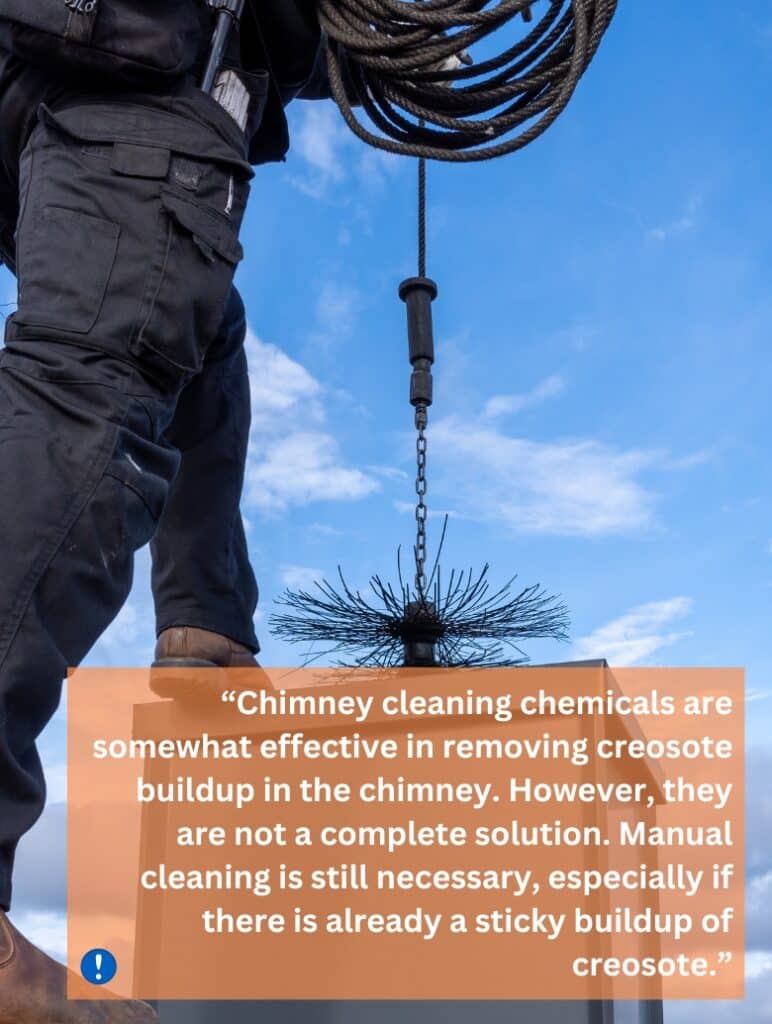
Chimney cleaning chemicals are somewhat effective in removing creosote buildup in the chimney. However, they are not a complete chimney cleaning solution. Manual cleaning is still necessary, especially if there is already a sticky buildup of creosote.
Creosote deposits are a common issue in chimney maintenance and can be categorized into three stages:
- Stage 1: In this initial phase, creosote presents as light ash, easily removable with basic cleaning tools.
- Stage 2: The creosote evolves into a flaky consistency, necessitating increased effort for removal.
- Stage 3: his advanced stage is characterized by creosote that has become glazed or hardened onto the chimney walls, typically requiring the expertise of professionals for effective removal.
When creosote reaches the final stage, it can cause ventilation problems. There is no clear path for smoke to come up because airflow is blocked inside the flue. Instead, these hazardous gasses can enter your home. Moreover, the risks of not cleaning chimneys go beyond just poor air quality. At this stage, the creosote becomes a serious fire hazard.
The National Fire Protection Association highlights that the leading cause of fireplace-related home fires is the ignition of this highly flammable creosote buildup. Addressing the creosote in its earlier stages can prevent these dangerous scenarios.
While chimney cleaning chemicals can mitigate some of the buildup, their effectiveness is limited, particularly against Stages 2 and 3 creosote, which is more deeply embedded into the chimney walls. This underscores the importance of regular and thorough manual cleaning in maintaining a safe and functional chimney.
Types of Chimney Cleaning Chemicals
There are different types of chimney cleaning chemicals available in the market. Here are the most common ones you will find:
Sodium chloride
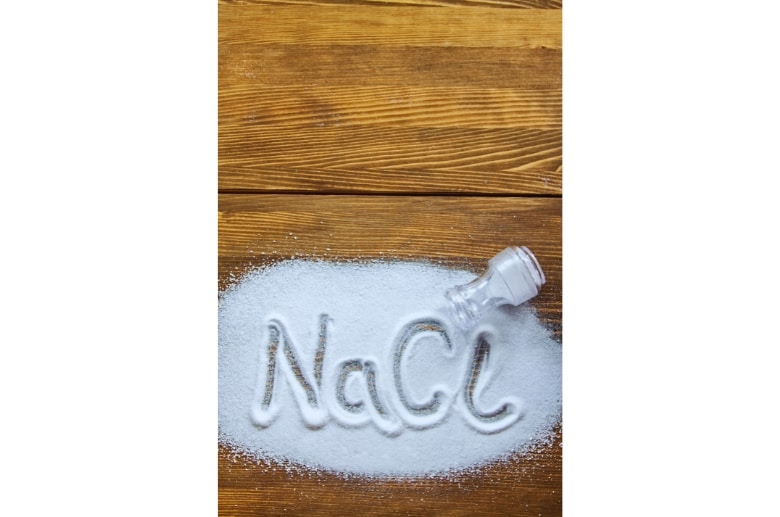
Also known as table salt, sodium chloride is one of the most easily accessible chimney chemical cleaners you will find. To use it, put a little salt in the fire while it’s burning. This, in combination with the water released from the hot fire, forms a weak acid that travels up the chimney and eliminates small amounts of creosote.
This type of chimney cleaner should be used with caution because the acid that it produces can be corrosive to certain materials, such as metal.
You may buy sodium chloride at any place where you usually get your table salt. Make sure to have a separate container designated to use for chimney cleaning as you don’t want your kitchen ingredients getting mixed up with your chemical cleaners.
Copper sulfate
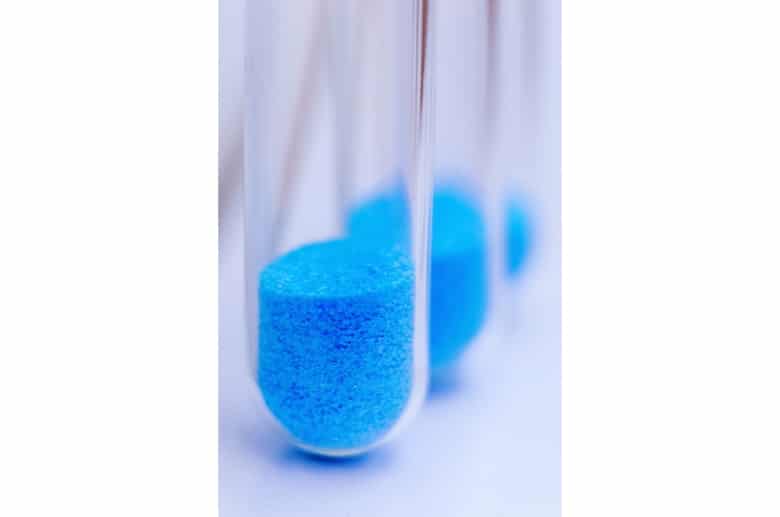
Another type of chimney chemical cleaner is copper sulfate which coats the soot in the chimney and acts as a catalyst so it burns away at a lower temperature than needed. It also comes in powder form, which you will put in the fire as it’s burning.
Be careful with using copper sulfate as like table salt, it too creates a sulfurous acid which can be corrosive to your chimney. You can find copper sulfate at any landscaping and hardware store. Copper sulfate can cost anywhere between $4 for 100g or $11 for 500g,
Anti-creosote sprays and powders
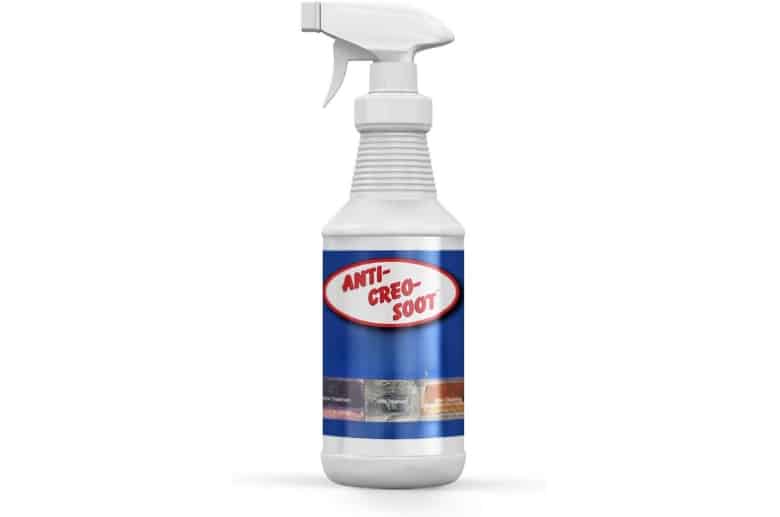
Anti-creosote spray is another type of chimney cleaning chemical that is easy to use. The chemical in the spray acts as a catalyst that attaches and destroys creosote and soot. Creosote turns into ash or char and then just falls off. This type of chimney cleaner is best suited for masonry and metal chimneys.
To use it, spray the product onto the walls of the fireplace and on the burning wood. Up to about 6 to 12 squirts depending on the amount of buildup. Once done, leave the fire to burn for at least 45 minutes. Be careful not to let the fire get too hot to prevent overheating at the beginning of creosote control.
Anti-creosote spray can be purchased at any hardware store or online at Amazon. A popular brand called Rutland has one of these anti-creosote sprays, and a bottle containing 32 fluid ounces costs $17.99.
Chimney sweeping logs
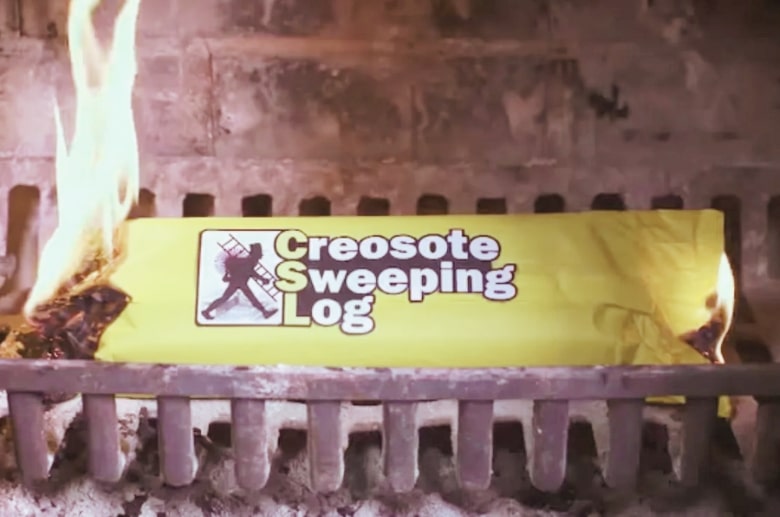
Chimney sweeping logs also referred to as creosote sweeping logs, are a special type of log that you burn in order to clean your chimney. It contains active minerals which activate when burned loosening creosote buildup in the flue.
You can put this log on your next fire and it will release chemicals that reach the creosote deposits and break them down into smaller fragments. You can burn this type of log every week or every month, depending on how often you use your fireplace.
The great thing about chimney sweeping logs is that they are non-corrosive, so they can be used on all types of chimneys.
Only use chimney sweeping logs on a wood-burning fireplace and not on gas or propane fireplaces, as these don’t require the use of logs to burn. And be sure to sweep out the loose creosote after each use, as this can easily catch fire.
These creosote sweepings can be bought at hardware stores or online for about $18 for each log.
——
Do You Need to Hire Chimney & Fireplace Expert?
Get free quotes from qualified experts near you. No commitment required!
——
Pros and Cons of Using Chimney Cleaning Chemicals
Here are the pros and cons of chimney cleaning chemicals
Pros:
- Easy to do it yourself.
- Cheap and commercially available.
- Peace of mind from fire hazard.
Cons:
- Copper sulfate is an acid that could damage the chimney, especially metal-lined chimneys.
- Some chemicals in cleaners contain very powerful compounds such as trisodium phosphate (detergent), manganese acetate (desiccant), cristobalite (silica), and tridymite (silica), which are a fire hazard.
- Not as effective as a professional cleaning
Effectiveness of Chimney Cleaning Chemicals
A test conducted by Mother Earth News discovered that chimney cleaning chemicals don’t work as well as they’re advertised. Based on their findings, chemical chimney cleaners didn’t have a substantial effect in removing creosote.
The testers looked for signs of prevention of creosote buildup and disappearance once formed. They also checked for changes in the creosote’s brush ability and flammability. They compared these results with the chimneys that were untreated with chimney cleaning chemicals and saw no substantial difference.
In the experiment, they used oak and pine to burn both cool and hot fires. They also tried different quantities of chemicals to see if they affected the prevention of creosote buildup.
They concluded that temperature played a bigger role in preventing the buildup than using these chemical cleaners.
Small fires tend to produce a cleaner burn and less smoke. They also found that small fires do not create as much creosote buildup. The tar glaze that forms in the chimney transforms into a dry, flaky deposit that falls off on its own. This kind of creosote deposit is lightweight and easier to clean since it’s still in the earlier stages. The researchers also found that high-temperature fires tend to create stickier buildup.
In this research, they concluded that chimney cleaners should only act as a supplement, not the only solution to maintaining your chimney.
How to Prevent Creosote Buildup and Maintain a Clean Chimney
Here are some steps you can take in order to prevent creosote buildup in your chimney:
Use only seasoned firewood
Use the driest wood you can find, like oak, maple, and birch, as these have the least amount of sap that can clog up your chimney. Avoid unseasoned wood as it contains a high percentage of water which means it will not burn wood efficiently.
The water vapor, in combination with other gases and particles, creates a buildup of creosote substance, which can harden inside your chimney. Worse, if your chimney is unlined, the tar that forms can seep into the brickwork.
Warm up the flue before lighting a fire
Warming up the flue, also referred to as preheating the flue, is essential to maintaining an efficient chimney. When your fireplace is not in use, especially during the cold months, your chimney is full of cold air.
This cold air essentially acts as a plug that blocks heat and smoke from going up. So when you start a fire, the heat and smoke will take the path of least resistance and spread into your home. Heated air must always move upwards out of the chimney, hence the need to preheat your flue.
To warm up the flue, roll a newspaper page tightly and light one end to make a torch. You may need to use a couple of these torches before the air within the flue is sufficiently heated.
Create appropriate-sized fires
When using the fireplace, go for a small intense fire as opposed to large smoldering fires. Large fires create more smoke which hastens creosote buildup.
To create the right size fire in your fireplace, follow these simple steps:
- Step 1: Measure Your Firebox: Ensure your fire will fit by measuring the dimensions of your firebox. The fire should not touch the sides or top.
- Step 2: Gather Materials: Collect dry kindling and appropriately sized logs. The logs should be small enough to fit comfortably within your firebox.
- Step 3: Build the Base: Start with kindling at the bottom to create a quick-burning base.
- Step 4: Add Logs: Place a few smaller logs over the kindling. Arrange them loosely to allow air circulation.
- Step 5: Light the Fire: Light the kindling. As it burns, the heat will catch onto the logs.
- Step 6: Maintain the Fire: Add logs as needed, but keep the size manageable and within the confines of the firebox.
This method ensures a small, intense fire that is efficient produces less smoke and fits perfectly in your firebox, reducing the risk of creosote buildup.
Inspect your fireplace and chimney regularly
The more you use your fireplace, the more cleaning it’ll need. Inspect your chimney regularly to make sure there are minimal creosote deposits. No more than a quarter inch is ideal. If it’s thicker than that, hire professionals for an inspection and cleaning. Even if you don’t see any warning signs, have it checked by a professional anyway.
Make sure you do your chimney cleaning before fire burning season, preferably during summer when weather conditions are optimal and the roof is dry and safe to work on.
Professional cleaning
The best solution to removing creosote buildup is to get it professionally cleaned. Nothing replaces manually cleaning your chimney. You can have all types of chimney cleaning chemicals in your home, but you will still need to brush off the interior of your chimney.
——
Do You Need to Hire Chimney & Fireplace Expert?
Get free quotes from qualified experts near you. No commitment required!
——
Safety Precautions When Using Chimney Cleaning Chemicals
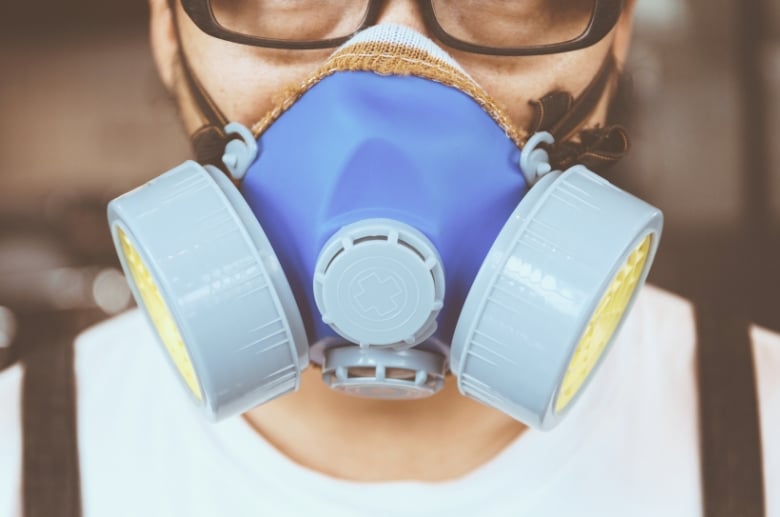
Here are some safety precautions you should follow when cleaning your chimney using cleaning chemicals.
- Read and Follow Instructions Carefully: Before using any chimney cleaning product, thoroughly read and understand the manufacturer’s instructions. This ensures correct usage and highlights any specific safety warnings.
- Wear Protective Gear: Always wear appropriate protective equipment, including:
Gloves: To protect your hands from chemicals and soot.
Googles: To prevent particles or chemicals from getting into your eyes.
Dust mask or respirator: To avoid inhaling soot, dust, or chemical fumes.
- Ensure Good Ventilation: Open windows and doors in the room where you’re working to ensure good airflow. Good ventilation helps in dispersing any fumes or airborne particles.
- Avoid Direct Contact with Skin and Eyes: Chimney cleaning chemicals can be harsh and may cause irritation. Avoid direct contact with your skin and eyes, and wash any exposed areas immediately if contact occurs.
- Keep Children and Pets Away: To avoid accidental exposure, ensure that children and pets are not in the vicinity when you’re using chimney cleaning chemicals.
- Use the Right Amount: Do not exceed the recommended amount of chemicals as specified by the product instructions. Overuse can lead to excessive fumes or residues.
- Dispose of Debris and Chemicals Properly: After cleaning, safely dispose of any debris or leftover chemicals according to local regulations.
- Avoid Mixing Chemicals: Never mix different chimney cleaning chemicals unless explicitly stated by the manufacturer. Mixing chemicals can lead to dangerous reactions.
- Be Cautious with Flames: If your chimney cleaning method involves burning a substance (like a creosote sweeping log), ensure that your fireplace is clear of any flammable materials and that the fire is fully extinguished after the process.
- Check for Structural Integrity: Before using chemicals, ensure that your chimney is structurally sound. Using chemicals in a damaged chimney could exacerbate issues.
- Be Prepared for Emergencies: Keep a fire extinguisher, first aid kit, and emergency contact information readily available in case of accidents.
- Consider Professional Assistance: If you’re unsure about using chemicals or if the chimney is heavily soiled, it might be safer and more effective to hire a professional chimney sweep.
Always remember that while chemical cleaners can assist in maintaining your chimney, they are not a substitute for professional inspection and cleaning, especially if there’s substantial creosote buildup or other issues. Regular professional inspections are key to ensuring chimney safety and efficiency.
Alternatives to Chimney Cleaning Chemicals
An alternative to using chimney cleaning chemicals is to sweep it yourself! Be warned: it’s one of the messiest jobs you’ll ever do!
Here is a quick step-by-step on how to clean your chimney:
- Step 1: Prepare all the tools you will need, such as a fireplace poker, goggles, respirator, vacuum, poly sheeting, canvas tarp, duct tape, special brushes, extension rods, and flashlight.
- Step 2: Protect the interior of your home by covering the fireplace in poly sheeting.
- Step 3: Insert a vacuum hose through the polysheet and connect it to the shop vacuum outside.
- Step 4: Begin brushing the flue of the chimney to remove the soot. Start from the top of the chimney and continue adding extension rods as you move down.
- Step 5: Run the vacuum as you brush. Replace the filter if you notice it’s clogged.
- Step 6: As you move the brush down, if you notice there’s no more brush resistance, that means you’ve reached the smoke chamber. You’re done cleaning the flue.
- Step 7: You’ll also need to clean the smoke chamber and firebox using special kinds of brushes that are abrasive enough to remove tough dirt but not damage the material.
- Step 8: Carefully collect and dispose of any debris or soot that has fallen into the fireplace.
- Step 9: Do a final inspection to ensure all creosote has been removed and that there are no blockages.
Another solution is to use a professional chimney maintenance company. They are chimney and fireplace experts with experience in all kinds of chimneys, so they have all the tools needed for cleaning them.
——
Do You Need to Hire Chimney & Fireplace Expert?
Get free quotes from qualified experts near you. No commitment required!
——
Conclusion
Chimney cleaning chemicals may help reduce creosote buildup, but their effectiveness is limited. It is still best to schedule regular professional cleanings and inspections. This is to ensure your chimney works optimally and your home is risk-free from fires.
When using your fireplace, remember to burn small, intense fires using dry wood. Always follow the safety guidelines when applying chemical cleaners, and mark it on your calendar to schedule your annual professional sweep.
Take action now to ensure the health and safety of your chimney.






